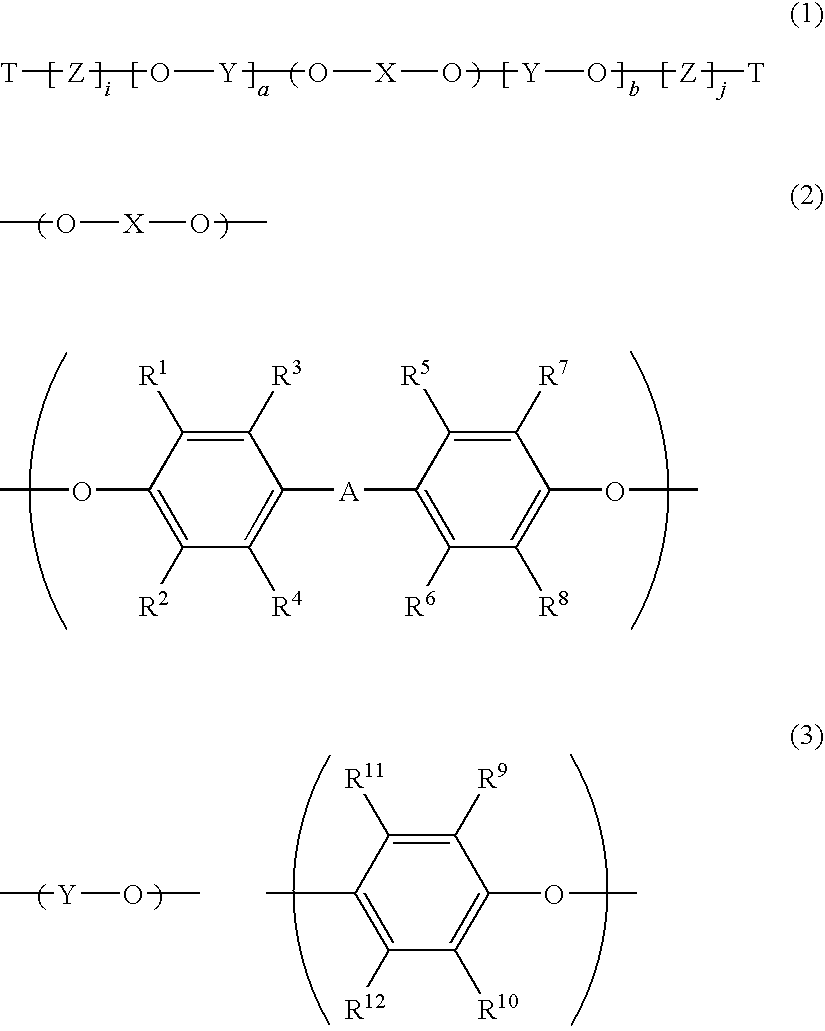Curable resin composition
a technology of resin composition and cure resin, which is applied in the direction of synthetic resin layered products, metal layered products, domestic applications, etc., can solve the problems of poor dielectric properties in a high frequency region, poor electrical properties, and high solder heat resistan
- Summary
- Abstract
- Description
- Claims
- Application Information
AI Technical Summary
Benefits of technology
Problems solved by technology
Method used
Image
Examples
synthesis example 1
[0248]0.481 mol (68 ml) of divinylbenzene, 0.362 mol (52 ml) of ethylvinylbenzene, 47 ml of a dichloroethane solution (concentration: 0.634 mmol / ml) of 1-chloroethylbenzene (30 mmol), 65 ml of a dichloroethane solution (concentration: 0.035 mmol / ml) of n-tetrabutylammonium chloride (2.25 mmol), and 500 ml of dichloroethane (dielectric constant: 10.3) were charged into a 1,000 ml-flask. 22 ml of a dichloroethane solution (concentration: 0.068 mmol / ml) having 1.5 mmol of SnCl4 was added to the mixture at 70° C., and the whole was reacted for an hour. A polymerization reaction was stopped with a small amount of methanol subjected to bubbling with nitrogen. Then, the reaction mixture was charged into a large amount of methanol, to thereby precipitate a polymer. The obtained polymer was washed with methanol, separated through filtration, dried, and weighed, to thereby obtain 67.4 g (yield: 61.4 wt %) of a copolymer A. A polymerization activity was 44.9 (g polymer / mmolSn·hr).
[0249]The obt...
synthesis example 2
[0251]0.481 mol (68.4 ml) of divinylbenzene, 0.0362 mol (5.16 ml) of ethylvinylbenzene, 63 ml of a dichloroethane solution (concentration: 0.634 mmol / ml) of 1-chloroethylbenzene (40 mmol), 11 ml of a dichloroethane solution (concentration: 0.135 mmol / ml) of n-tetrabutylammonium bromide (1.5 mmol), and 500 ml of dichloroethane (dielectric constant: 10.3) were charged into a 1,000 ml-flask. 1.5 ml of a dichloroethane solution (concentration: 0.068 mmol / ml) having 1.5 mmol of SnCl4 was added to the mixture at 70° C., and the whole was reacted for an hour. A polymerization reaction was stopped with a small amount of methanol subjected to bubbling with nitrogen. Then, the reaction mixture was charged into a large amount of methanol, to thereby precipitate a polymer. The obtained polymer was washed with methanol, separated through filtration, dried, and weighed, to thereby obtain 54.6 g (yield: 49.8 wt %) of a copolymer B. A polymerization activity was 49.8 (g polymer / mmolSn·hr).
[0252]The...
example 1
[0294]The copolymers A and B obtained in Synthesis Examples described above, PPE, OPE-2St-1 to 3, the reaction initiator P-1, the thermoplastic resin T-1, and the heat-curable resin E-7 were mixed in amounts described in Table 1 with toluene as a solvent. The mixture was stirred, and the reaction initiator P-1 was added, to thereby prepare a solution of a heat-curable resin composition.
[0295]The solution of a heat-curable resin composition was cast on a board having a polyethylene terephthalate resin (PET) sheet attached, to thereby obtain a film. The obtained film had a thickness of about 50 to 60 μm, was not sticky and the like, and had excellent film formation property. This film was dried at 80° C. for 10 minutes in an air oven, and heat-cured at 180° C. for 1 hour with a vacuum press forming machine, to thereby obtain a cured film having a thickness of about 50 μm.
[0296]This cured film was measured for tensile strength, stretch rate, dielectric constant, and dielectric dissipat...
PUM
| Property | Measurement | Unit |
|---|---|---|
| molecular weight distribution | aaaaa | aaaaa |
| glass transition temperature | aaaaa | aaaaa |
| interlayer distance | aaaaa | aaaaa |
Abstract
Description
Claims
Application Information
 Login to View More
Login to View More - R&D
- Intellectual Property
- Life Sciences
- Materials
- Tech Scout
- Unparalleled Data Quality
- Higher Quality Content
- 60% Fewer Hallucinations
Browse by: Latest US Patents, China's latest patents, Technical Efficacy Thesaurus, Application Domain, Technology Topic, Popular Technical Reports.
© 2025 PatSnap. All rights reserved.Legal|Privacy policy|Modern Slavery Act Transparency Statement|Sitemap|About US| Contact US: help@patsnap.com



